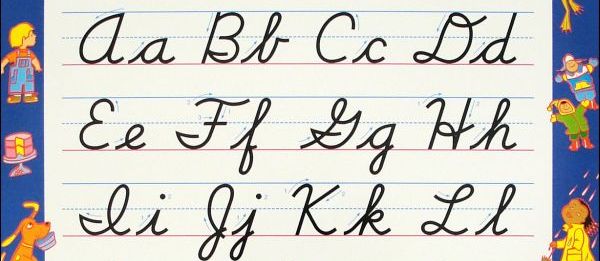In an age when more and more children learn their letters from a handheld digital device, our youngest generation is rather quickly losing the old-fashioned skill of connecting those letters in a fluid, cursive script. In high-tech Washington state, the home of Microsoft, legislators are considering a bill that would require the teaching of cursive writing (http://app.leg.wa.gov/billinfo/summary.aspx?bill=6469&year=2015 ) in all public schools. Having adopted the Common Core standards which do not specifically require handwriting instruction, some schools are skipping it altogether.
I have a vivid memory from early childhood, of writing an obligatory thank-you note under my mother’s supervision, proudly trying out my new cursive skills. They must not have been very good yet, because I remember it being painfully difficult – It takes a great deal of patience and practice, over time, to develop the muscle memory sufficient to master a new motor skilllike trying to move my hand through a pool of syrup – to connect those letters. I gave up midway through and switched to print letters. I had not yet developed the “muscle memory” required to make an easy connection between one letter and the next. It takes a great deal of patience and practice, over time, to develop the muscle memory sufficient to master a new motor skill, such as when a baby learns to walk, or a child learns to ride a bike, shoot a perfect basket, or play the piano. Once you have that muscle memory, though, it lasts a lifetime.
Those of us older than second grade may have forgotten how we learned to write cursive, just as we have no memory of how we learned to walk, when they learn the habits of patience, practice, and perseverance, it can have a major payoff in brain developmentbut visit any of Cedar Tree’s pre-Grammar classes and you will see the intense work the skill of cursive writing requires. Small hands have to grasp pencils in just the right way, young minds have to distinguish between a “b” and a “d” or between an “o” and an “a.” The connecting line has to touch the baseline usually… but not always. Some letters have to be revisited for a dot or a cross-mark after the rest of the word is written. For some children, this may be their first experience of frustration at school; but when they learn the habits of patience, practice, and perseverance, it can have a major payoff in brain development for years to come, as research in psychology indicates.
I cannot think about the process of learning to write cursive without I am awed by the benevolence of our Creator God, who designed the human brain with the unique capability to use language, to read, to writefeeling profound gratitude for the great patience and persistence of the long-ago teachers who influenced my life. Even more than that, though, I am awed by the benevolence of our Creator God, who designed the human brain with the unique capability to use language, to read, to write. In developing those gifts to the best of our ability, I believe we honor Him.
Kathy Chapman is Cedar Tree’s Upper School Latin teacher. She taught Latin at Cedar Tree from 2000 to 2016.






